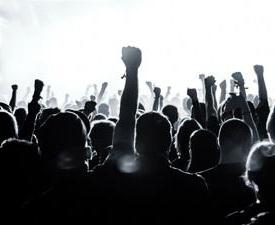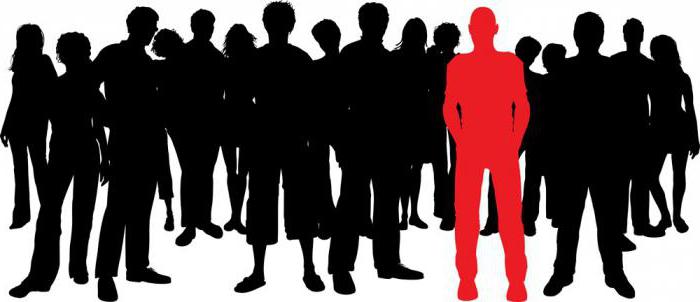"Ochlocracy" is a term meaning the power of a crowd. This concept first appeared and gradually matured in the philosophy of ancient Greece. The term "crowd power" was akin to the meaning of the word "democracy."
Ochlocracy - “wrong democracy”
To clarify the situation a little, let us turn to the ideas of Plato. According to him, there are three forms of government:
- monarchy;
- aristocracy;
- democracy.
Today, every student knows that a democratic form of government is fairer for society, but the best minds of antiquity had a slightly different point of view.
Forms of power from antiquity
In the modern theory of state and law, the monarchy is divided into constitutional, absolute, etc. But in ancient times, it was divided into legal (headed by the king) and violent, headed by the tyrant. Hence the term "tyranny." Which, in fact, is identical in our understanding with absolutism.
The aristocracy is the power of the few. A true aristocracy is the rule of the best people. And, according to the cleverest educators of antiquity, it is precisely it that is the “correct” form of government that leads society to success. Another form is the oligarchy, or the power of the worst.
And finally, democracy was divided into legal and lawless. The latter was called "ochlocracy," or violent, demagogic power. This is ochlocracy today - the power of the crowd. In antiquity, this is a form of government. Although then, as today, the term had a negative assessment.
Aristotle on Ochlocracy
According to Aristotle, ochlocracy is not just the power of the crowd, but a perverted manifestation of true democracy.
The thinker gives a concrete example from history when the power of the crowd, or, as he called it, “ordinary mob”, negatively affects the economic and political situation of the policy. The lesson is the rule of Pericles in Athens. Modern history textbooks loudly call this period the heyday of democracy. But the smartest people of that time had a different point of view. Having removed the "best" people (the modern interpretation of "professionals"), the "ordinary mob" began to rule the country. Who exactly was responsible for what - chose the lot.
The consequences are logical: the complete collapse of economic and political development, the flowering of arbitrariness and despotism. The result is one - the power of the crowd, or ochlocracy, as the highest manifestation of democracy is destructive for the whole society as a whole.
Examples of “disastrous democracy”
You can understand the ancient scholars. Just for a second, imagine that all positions in society are distributed through lots. For example, a person who has been repairing cars all his life suddenly becomes the general director of an agricultural holding by chance. It is easy to guess that the probability of the ruin of an economically developed enterprise is very high. Now it’s clear why ancient scholars believed that democracy, at its worst, becomes ochlocracy - recall that this is a term denoting the power of the crowd, or, in modern terms, the management of lay people.
That is why the aristocracy, in their opinion, is the best form of government, since smart, knowledgeable professionals are at the head. In fairness, many can cite a number of cases in which successful parents after death left multimillion-dollar enterprises to their children. Only a few continued their work well. The rest, as a rule, ruined or sold these enterprises due to lack of professionalism and inability to manage.
Examples of ochlocracy in Russia
Unfortunately, history lessons often remain forgotten. Let us recall the revolutionary events in Russia, when the power of the crowd prevailed in 1917. The army turned out to be ineffective, the economy began to fall apart, there was a famine that was not connected economically with the First World War. The collapse comes when people who do not know the basics of governance, the possession of state power, are at the head of the country.
What does crowd power mean today? This is ochlocracy, which carries a deeper meaning. In modern political life, this form manifests itself in times of crisis. During the years of revolution, civil war, during the transitional governments. Accordingly, today ochlocracy, as in ancient times, is negative.
Signs of modern ochlocracy
- Political course variability, unpredictability, impulsiveness of political decisions, populism, utopian ideas.
- A sharp economic downturn. The period of instability discourages capital and investors. Old industrial enterprises tend to close, and businessmen are simply waiting for better times and are looking for calmer countries.
- A sharp rise in crime. Even large-scale military operations or civil war are possible. Anarchy always gives rise to violence, poverty.

- Short time of existence. People get tired of all this, so the times of anarchy and arbitrariness, as a rule, end very quickly by the standards of human history. Of course, we can recall the protracted conflict during the Hundred Years War, when bloodshed lasted more than a hundred years. But this is a slightly different example, which illustrates the mores of the time rather than the political crisis in Europe.
- In addition to the 1917 revolution , similar events have repeatedly occurred in our country. For example, this manifested itself during the Time of Troubles at the beginning of the 17th century. The social explosion and the power of the crowd led the country to plunge into the chaos of wars and revolutions for almost 15 years.
Reasons for Ochlocracy
The power of the crowd is not just a spontaneous phenomenon that appears suddenly, like a thunderstorm in the clear sky. The manifestation of ochlocracy is associated with many factors. Very often, it occurs during a political crisis of the current government. People simply do not believe her and take control in their own hands. Some are desperate, others are trying to extract momentary benefits. But the result is always the same - the deterioration of the political, economic and social life of the state.
Ochlocracy after the collapse of the Union
This could be observed in Russia after the collapse of the USSR. Formally, ochlocracy was to appear immediately, in the first years after the collapse, since the entire political system in the country collapsed completely, and another did not take its place. But we must pay tribute to the strong political leader of that time - B.N. Yeltsin. Indeed, people today speak negatively of him. A lot of mistakes were made afterwards. But the fact that the country was not bogged down in a civil, interethnic war throughout Russia, is only his merit.
Seeing a strong leader in the early 90s of the last century, many abandoned the idea of an open confrontation with Moscow. But the subsequent actions of the authorities, inflation, unfair privatization, the lack of powerful law enforcement agencies led to anarchy. As mentioned above, the power of the crowd is called ochlocracy. This concept was very clearly manifested at that time.
Distinctive properties of ochlocracy in Russia
The following can be distinguished:
- The growth of crime, crime. In the absence of political will and anarchy, the state replaced crime by taxing and levying the entire economy of the country. People were not afraid to leave tax services, but they were really afraid not to pay the so-called roof, crime. Civil liability, social justice did not bother entrepreneurs of that time. But they can be understood. When corruption is not even hidden, when people do not believe that money goes to the treasury, then, naturally, few people will believe such a government.
- Lack of pensions, salaries in the public sector, social benefits. It is easy to guess what this leads to. People survived as they could.
- Departure into the illegal field of business. In the absence of leverage from fiscal and law enforcement agencies and open propaganda of corruption, this was not surprising.
- Lynching and "showdown". Of course, few believed in honest courts. Everyone judged according to their sense of justice. Often this led to a chain reaction and protracted local wars between citizens on the principle of military democracy “an eye for an eye, a tooth for a tooth”.
The crowd as a petty manifestation of ochlocracy
The problem is that an uncontrolled crowd does not have specific goals. She is always spontaneous. She has no clear plans. What will be the next step is decided instantly. Political technologists know very well that the power of the crowd is called anarchy. The manifestation of ochlocracy on a reduced scale can be observed during the spontaneous performances of football fans, for example, as well as during peaceful pickets and demonstrations. There is even the special term "provocateurs in the crowd." These are people who feel the "warmth" of the crowd and can effectively direct it into an aggressive channel.

Similar phenomena were observed at political rallies on Bolotnaya Square in Moscow. But the Ministry of Internal Affairs knew in advance about such provocateurs and blocked them in time. You can recall the pogrom of fans in Moscow in 2002, when after the defeat of the Russian football team, thousands of people went to destroy and smash everything in their path. Today it is known that among them there were also special provocateurs who organized such a procession.
Thus, to summarize: the power of the crowd is called ochlocracy, but in fact it is a very broad and multifaceted concept.